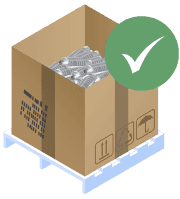Catalytic converter 101
What Are Catalytic Converters and How Are They Recycled?

Catalytic converters are vital parts of a vehicle’s exhaust system, and are packed with platinum, palladium, and rhodium. These three platinum group metals make catalytic converters valuable for scrap metal and automotive recyclers. But why? And how are they recycled?
We created a catalytic converter recycling guide to help you understand every step of the process, and give you the right information and the confidence to get the most from your material.
Why do we use catalytic converters?
In the 1970s, emission controls were introduced to reduce the ecological impact of harmful pollutants such as carbon monoxide, nitrogen oxides, and hydrocarbons. For this reason, catalytic converters became essential to all exhaust systems.
The catalyst material inside converters, made of platinum, palladium, and rhodium, causes a chemical reaction that transforms toxic gasses into less harmful emissions.
That’s why recycling catalytic converters is valuable. They contain precious metals that can be sold on the PGM market and returned to the global supply chain.
So when we talk about recycling scrap catalytic converters, we’re talking about the process of extracting platinum, palladium, and rhodium from the unit. In other words, precious metal recycling. Let’s take a look at the process of catalytic converter recycling.
The stages of catalytic converter recycling
Most used catalytic converters end up at a scrap yard, but to extract all precious metal content, they must be toll-refined. Let’s take a look at catalytic converter recycling with a toll refiner.
- Counting and grading: Units are separated by material type like OEM catalytic converters
- Decanning, crushing, and commingling: Metal pipes and shells are removed, and the cermamic is crushed and commingled into a homogenous powder.
- Sampling: Two or more samples are prepared for the assay analysis.
Assay: XRF and ICP devices measure the amount of platinum, palladium, and rhodium in the catalyst material..
Your assay report and getting paid
Your assay report allows you to understand your material and hedge your metal market values accordingly. A typical assay report gives you the following information about your scrap catalytic converters:
- Gross/net weights
- PPMs
- Converter counts
- Metal return percentages
- Precious metal market prices
- Units paid by the piece (extras)
- Processing fees
- Interest rates
- Hedged prices
This is when you can either hedge your material or ask for final payment.
What is hedging and when can you hedge your metals?
Hedging is the strategic process of locking in a precious metal current price so that even if the market changes, you’ll still receive payment based on that market price. It eliminates the risk that adverse market developments affect your return on investment.
You can hedge at different stages during the recycling process. At PMR, you can hedge before the end of your contract or after, depending on your tolling options, and hedge the prices of one, two, or all three metals, partially or fully.
And there you have it. That is the full extent of catalytic converter recycling!
For more toll-refining information, visit our Resource Center.
To learn more about our hedging and tolling options, call a representative.

